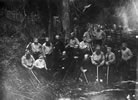First year of war
In the early stages of the war the Boers cut the railway linking Cape Colony with Rhodesia, and besieged both Ladysmith and Mafeking. The British responded by advancing north from Cape Colony. Johannesburg was captured on 31 May 1900, and Pretoria, the capital of Transvaal, on 5 June. By October both the Orange Free State and Transvaal had been annexed. It was assumed that mopping up would finish the war by the end of the year. The first five New Zealand contingents served in these operations.
A noted engagement for the New Zealanders came just over a month after the 1st Contingent had arrived, when 60 of them were occupying a hill overlooking Slingersfontain camp along with a Yorkshire regiment. When the Yorkshires came under severe attack, some of the New Zealanders charged with bayonets and the Boers turned and fled. In recognition of their efforts, the hill was renamed ‘New Zealand Hill’.
Last shots
Four days after the peace treaty was signed, two officers of the 9th Contingent, lieutenants Robert McKeich and Henry Rayne, rode out of camp to go shooting. They were surprised by three Boers who demanded they hand over their rifles and clothes. The Boers did not believe that peace had been declared and when McKeich resisted he was shot dead. Rayne shot one Boer dead, mortally wounded a second, and seriously wounded the third. Rayne was also wounded. McKeich, a butcher from Lawrence, and the two Boers were the last men killed by gunfire in the war.
Guerrilla war
Expectations of a quick victory were misplaced. With the British holding the main towns and railways, the Boers, moving fast and operating as small commando groups, sallied forth in quick guerrilla operations. The British responded by clearing the countryside of stock, burning crops and rounding up both Boer and African civilians into concentration camps, including women and children. This was partly so they could not supply food and support to the guerrilla fighters. The Six and Seventh contingents were involved in this.
This was not wholly successful, so in the final stages of the war the British left the women and children in the country, built blockhouses and began systematic sweeps to defeat the Boer guerrillas. In February 1902 the Boer leader Christiaan de Wet attempted to break the encroaching line. His men attacked at night with an advance screen of cattle at Langverwacht Hill, or Bothasburg as it was also known, in the Orange Free State. Members of the 7th Contingent were heavily involved and of some 90 men, 24 were killed and 41 wounded, making this the most costly action of the war for New Zealanders.
Eventually, on 31 May 1902 – not long after the 9th and 10th contingents had arrived – peace terms were signed.
Conditions
Most of the men who served in South Africa had undergone little training and were quickly into action. The 1st Contingent saw fighting within two weeks of arrival and they had little time to acclimatise. This seriously affected the horses, which were otherwise of superior quality.
The troopers’ equipment was poor, and on trek they had inadequate food – hard dry biscuits, bully beef (canned meat), sugar and tea. They tried to supplement this with much foraging. Their clothing quickly became ragged and was not replaced, which led men of the 6th Contingent to strike. They were not issued with soap and their clothing quickly became infected by lice. Often they had no blankets, and while it could be hot during the day on the veldt (open plains), it could be bitterly cold at night.
A lousy war
An officer of the 6th Contingent wrote: ‘My men … had to make the shirt, drawers and socks last six months without a change; and as opportunities for washing them seldom occurred, they became infected with vermin, which nearly distracted them. It was no uncommon sight to see a whole regiment, when halted for a few minutes, take off their shirts and go ahunting for the little pests.’1
Adding to the strain was the lack of rest and recreation, which explained why most troopers were keen to return home at the end of their 12-month term.
Sickness was rife – men suffered from malaria and typhoid (or enteric fever), and when they were wounded on the trek far from hospitals sepsis (infection) often developed. There were also riding accidents.
Casualties
Not surprisingly 133 troopers died from disease (over half from enteric fever), which represented more than half of the total deaths of 230. Of the other casualties, 71 were either killed in action or died of wounds, and 26 were accidentally killed – 16 of these were members of the 8th Contingent who died in a railway accident at Machavie. The 8th Contingent returned home in a ship that had not been properly disinfected, and many arrived home suffering from measles and pneumonia.



